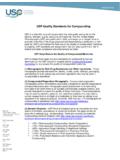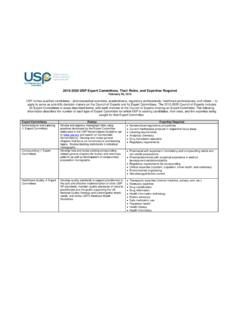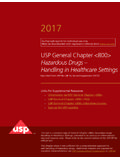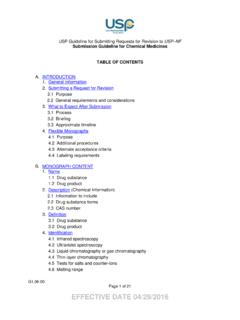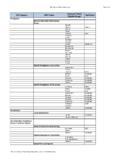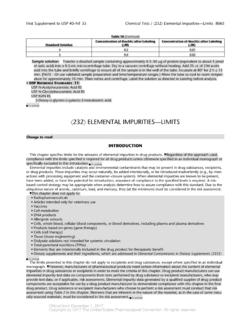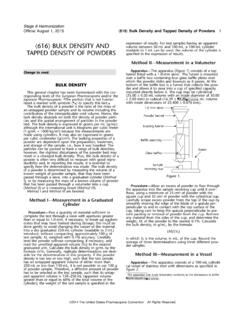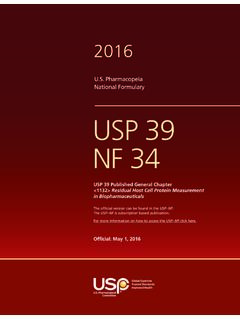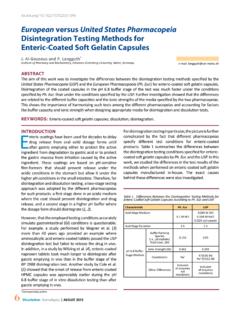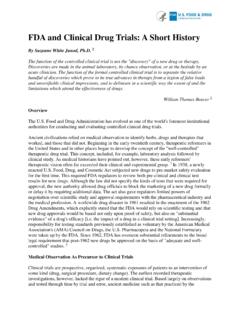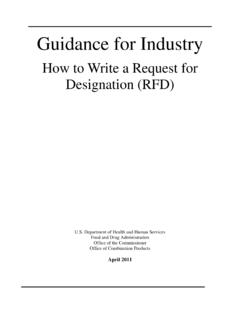Transcription of 11/21/2016 30(4) Harmonization: <905> UNIFORMITY OF …
1 11/21/201630(4) harmonization : <905> UNIFORMITY OF dosage 905 UNIFORMITY of dosage Units, USP 27 page 2396 and page 1587 of PF 28(5) [Sept. Oct. 2002].The United States Pharmacopeia is the coordinating pharmacopeia in the efforts toward internationalharmonization of the specifications provided in this general test chapter. The Stage 5B text for thischapter has been signed off by the Pharmacopeial Discussion Group members. The text presentedherein represents a merger of the Stage 5B text and the national USP text. This combined text, which isbeing published in this issue of PF for information only, not for public comment, is scheduled forpublication in USP 28 NF 23, with a scheduled implementation date of 1 April 2006.
2 Earlierimplementation by individual companies may be done at their differences between this current text and that of the STAGE 4 merged draft that was publishedon pages 1595 1599 of PF 28(5) [Sept. Oct. 2002] are listed The text discussing harmonization in the first paragraph of the STAGE 4 draft has been deletedin this current draft because the revised chapter will not officially be harmonized until the EPadopts the global text in the European Pharmacopoeia, Supplement , official December 2004and the JP adopts the global text in the JP XV, official April 2006. At that time USP will republishthis text with the addition of symbols for the national text throughout and with the explanatoryintroductory text, Portions of this general chapter have been harmonized with the correspondingtexts of the European Pharmacopoeia or the Japanese Pharmacopoeia.
3 Those portions that arenot harmonized are marked with symbols ( ) to specify this fact. 2. The term active ingredient in the STAGE 4 draft has been replaced globally by the preferredterm drug substance .3. In the current listing of dosage forms that require testing by Content UNIFORMITY (see item C3 inthe text), suspensions or emulsions or gels in unit dose containers or in soft capsules that areintended for systemic administration only are distinguished from those that are intended forexternal, cutaneous A new Table 1, linking the various dosage forms to the appropriate UNIFORMITY of dosage Unitstest procedure, has been added to the current The text listing those dosage forms for which Weight Variation is applicable has been revised The definition for the reference value M in Table 2 has been revised to indicate coverage ofcases where the target test sample amount (amount of drug substance) at time of manufacture,T, is either (a) less than or equal to , or (b)
4 Greater than The variable U, an overage factor that was indicated for use in cases where the drug productwas formulated with an overage of drug substance to compensate for stability losses duringproduct shelf life, has been deleted from the current text. The addition of such overages is nolonger considered to be The text regarding the term Acceptance Value, AV, has been expanded for The text relating to the variables L1 and L2 in Table 2 has been expanded, and the values and have been replaced by formulas that clarify how the computations are The first paragraph in the Weight Variation section of the current text contains new text forclarity. This text indicates that the assay results, designated as A, are to be expressed as % oflabel claim.
5 11. Revised text stating that the drug substance concentration is assumed to be uniform (throughoutthe batch) has been added to the first paragraph under Weight Variation. For the purpose of thischapter, tablet concentration, unlike tablet content, is assumed to be independent of individualdosage unit weight when Weight Variation is (4) harmonization : <905> UNIFORMITY OF dosage (PDF: W. L. Paul ) RTS 41183 1 Change to read: 905 UNIFORMITY OF dosage UNITSNOTE In this chapter,unitanddosage unitare UNIFORMITY of dosage units can be demonstrated by either of two methods, weight variation orcontent UNIFORMITY . The requirements of this chapter apply both to dosage units containing a singleactive ingredient and to dosage units containing two or more active ingredients unless otherwisespecified in the individual monograph, they apply individually to each active ingredient in the UNIFORMITY requirements may be applied in all cases.
6 The test for Content UNIFORMITY isrequired for:1. coated tablets, other than film coated tablets containing 50 mg or more of an active ingredientthat comprises 50% or more (by weight) of one tablet 2. transdermal systems 3. suspensions in single unit containers or in soft capsules 4. inhalations (other than solutions for inhalation packaged in glass or plastic ampuls, intendedfor use in nebulizers) packaged in premetered dosage units (For inhalers and premetered dosageunits labeled for use with a named inhalation device, also see Aerosols , Metered Dose Inhalers,and Dry Powder Inhalers 601 ) 5. solids (including sterile solids) that are packaged in unit dose containers and that containactive or inactive added substances, except that the test for Weight Variation may be applied inthe special situations stated below and6.
7 The test for Content UNIFORMITY is not required, the test for Weight Variation may be applied inany of the following situations:1. products containing 50 mg or more of an active ingredient comprising 50% or more, byweight, of the dosage unit or, in the case of hard capsules, the capsule contents, except thatuniformity of other active ingredients present in lesser proportions is demonstrated by meetingContent UNIFORMITY requirements 2. liquid filled soft capsules other than soft capsules containing suspensions 3. solids (including sterile solids) that are packaged in single unit containers and contain noadded substances, whether active or inactive 4. solids (including sterile solids) that are packaged in single unit containers, with or withoutadded substances, whether active or inactive, that have been prepared from true solutions andfreeze dried in the final containers and are labeled to indicate this method of preparation and5.
8 Solutions for inhalation packaged in glass or plastic ampuls, intended for use in nebulizers, oralsolutions, and syrups when these articles are packaged in single unit (4) harmonization : <905> UNIFORMITY OF dosage VARIATIONFor the determination of dosage unit UNIFORMITY by weight variation, select not fewer than 30 units,and proceed as follows for the dosage form designated. [ NOTE Specimens other than these test unitsmay be drawn from the same batch for Assay determinations. ]Uncoated and Film Coated Tablets Weigh accurately 10 tablets individually. From the result of theAssay , obtained as directed in the individual monograph, calculate the content of active ingredient ineach of the 10 tablets, assuming homogeneous distribution of the active Capsules Weigh accurately 10 capsules individually, taking care to preserve the identity of eachcapsule.
9 Remove the contents of each capsule by a suitable means. Weigh accurately the emptied shellsindividually, and calculate for each capsule the net weight of its contents by subtracting the weight ofthe shell from the respective gross weight. From the results of the Assay , obtained as directed in theindividual monograph, calculate the content of active ingredient in each of the capsules, assuminghomogeneous distribution of the active Capsules Determine the net weight of the contents of individual capsules as follows. Weighaccurately the 10 intact capsules individually to obtain their gross weights, taking care to preserve theidentity of each capsule. Then cut open the capsules by means of a suitable clean, dry cuttinginstrument such as scissors or a sharp open blade, and remove the contents by washing with a suitablesolvent.
10 Allow the occluded solvent to evaporate from the shells at room temperature over a period ofabout 30 minutes, taking precautions to avoid uptake or loss of moisture. Weigh the individual shells,and calculate the net contents. From the results of the Assay , obtained as directed in the individualmonograph, calculate the content of active ingredient in each of the capsules, assuming homogeneousdistribution of the active (Including Sterile Solids) in Single Unit Containers Proceed as directed for Hard Capsules,treating each unit as described for Inhalation Packaged in Glass or Plastic Ampuls, Intended for Use in Nebulizers Proceed as directed for Hard Capsules , treating each unit as described Solutions and Syrups Packaged in Single Unit Containers Weigh accurately the amount ofliquid that drains in not more than 5 seconds from each of 10 individual containers.
